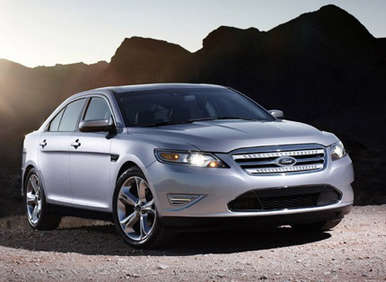Recent Articles
Popular Makes
Body Types
Ford Taurus Used-Car Buying Guide
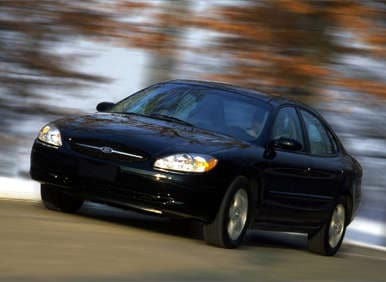
Few cars have influenced the automotive landscape the way the Ford Taurus has. At its introduction back in 1986, the Taurus was a groundbreaking model, one which spawned a fan base like no other family sedan has before it or since. Its revolutionary aerodynamic shape, exceptional feature set, outstanding comfort, and wonderfully affordable price tag immediately assured it a place in the automotive hall of fame.
Unfortunately, these attributes made it a hard act to follow too.
Easily one of the best-selling cars in America throughout its first 10 years of production, subsequent models weren’t nearly as innovative. Ford, resting on its laurels vis-à-vis the Taurus, was focusing heavily on its trucks and SUVs during the second decade of the Taurus’ lifetime. So much so, Ford allowed the Taurus to stagnate. The market responded predictably and more competitive models from Asia filled the void, supplanting the Taurus as the best-selling car in America.
Eventually, things got so bad the Taurus was relegated to rental fleets only while Ford introduced new models in the Taurus’s space with different names. The Ford 500, and the Ford is Freestyle were basically the Taurus in disguise. However, marketers mistakenly thought the Taurus name had lost its attraction. Ford's current CEO, Alan Mullaly felt this was a mistake and ordered the Taurus name revived. He was proven correct. Today, the Taurus is once again one of Ford's best-selling models.
There have been six generations of the Taurus produced since the original was introduced in 1986. For the purposes of this buyer's guide, we will focus on the fourth, fifth, and sixth generations—starting with model year 2000.
Ford Taurus Used-Car Buying Guide: 2000 – 2007
The fourth-generation Ford Taurus was introduced in model year 2000. Rather than continuing down the radical design path for which it had become noted, the shape of the fourth-generation car was considerably more conservative. This was in an effort to increase the car’s market appeal. The interior was also redesigned to appear more conventional.
In this case however, conventional wasn't such a bad thing.
Many had considered the previous generation’s heavy reliance upon ovals as the primary design cue overwrought. The fourth-generation car kept the overall shape of the third-generation car but the detailing was more squared off, resulting in arguably a more handsome car.
Engine choices for the fourth-generation model were both 3.0 L V6 engines. A four-speed automatic was the only transmission choice for the front drive powertrain. Low-end models got the 155 hp version of the 3.0 L, while the more luxurious models got the double overhead cam 200 hp engine.
There was also a station wagon version of the Taurus.
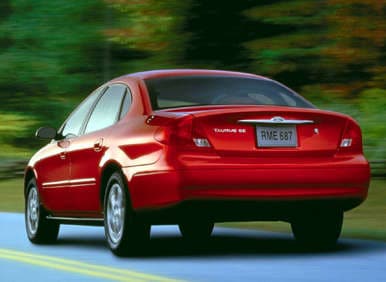
Ford Taurus Used-Car Buying Guide: 2000
The 2000 Ford Taurus was introduced in four states of trim; “LX”, “SE”, “SES”, and “SEL”.
LX was the base model. Its standard features included; front bucket seats, a center console, a lighted entry system, power brakes, a rear window defroster, 16-inch steel wheels, and driver and front passenger airbags.
The Taurus LX ran a single overhead cam, 155 hp version of the V6 and used cloth upholstery. The LX also featured power steering, a remote trunk release, a tilt steering wheel, air conditioning, and intermittent windshield wipers. Power features included the windows and the exterior mirrors. An AM/FM audio system provided news and tunes.
The options list contained a keyless entry system, alloy wheels, ABS, front side airbags, an antitheft alarm system, a power driver seat, cruise control, power door locks, and an AM/FM/cassette audio system.
For Taurus SE, most of the LX’s optional features were standard. The SE’s options included the 200 hp double overhead cam V6 enginea compact disc changer, traction control, front side air bags, a split front bench seat, a split rear bench seat, a power driver’s seat, and power adjustable pedals.
The Taurus SES was equipped largely the same as the Taurus SE, however its option list also contained power heated mirrors, a power moon roof and traction control, plus leather upholstery and steering wheel trim.
The top-of-the-line Taurus SEL got all of the standard features and most of the options of the SES as standard equipment. The SEL’s extras included a power front passenger seat and a rear spoiler as options. The SEL got automatic on/off headlights as standard equipment and was powered exclusively by the 200 hp double overhead cam version of the V6.
The Taurus wagon came only in SE trim; however many of the features of the Taurus SES sedan were either standard equipment, or options for the Taurus SE wagon. This model included front bucket seats, a center console, a keyless entry system, a lighted entry system, a power antenna, and power brakes. It rode on a set of 16-inch alloy wheels and featured driver and passenger front airbags.
The Taurus SE wagon also had an antitheft alarm system, cloth upholstery, cruise control, power steering, and a tilt steering wheel. Air conditioning, intermittent windshield wipers, power windows, and a rear window wiper were standard equipment as well. The model used power door locks, power exterior mirrors, a roof rack, and an AM/FM/cassette audio system.
Optional features included a compact disc changer, heated exterior mirrors, a power moon roof, and a third seat. Traction control, four-wheel ABS, front side airbags, and leather upholstery also graced its options list—as did a power driver seat, power adjustable pedals, and leather steering wheel trim.
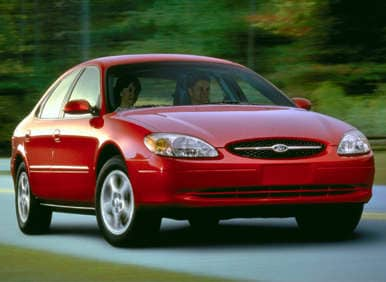
Ford Taurus Used-Car Buying Guide: 2001
For model year 2001, Ford added a Lower Anchor And Tether For Children (LATCH) system for child safety seats, the fuel tank capacity was increased to 18 gallons, a six-disc CD changer was made standard for SES, power door locks were made standard for the LX, and that model also got an optional rear spoiler.
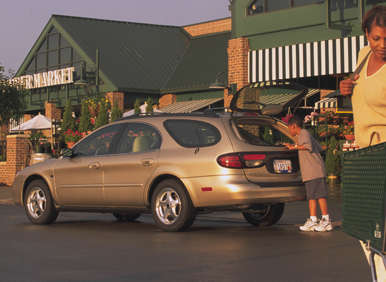
Ford Taurus Used-Car Buying Guide: 2002
For 2002, the Taurus LX offered floor mats, the 155 hp V6 engine, air conditioning, rear defogger, power windows and locks, stereo, anti-theft system and tilt steering wheel as standard features.
The 2002 Taurus SE added aluminum wheels, safety approach lamps, a power driver seat, cruise control, a CD player, and remote keyless entry.
The SES Ford Taurus featured illuminated vanity mirrors, a split-folding rear seat and antilock brakes.
The SES Deluxe package added the 200-hp V6 engine, five-passenger seating, a rear spoiler, a leather-wrapped steering wheel, a moonroof, and leather upholstery.
The full-boat 2002 Ford Taurus SEL used machined aluminum wheels, leather upholstery, a moonroof, a six-disc in-dash CD changer, and an automatic climate control system.
On the wagon side, an SEL trimmed model debuted featuring; 16-inch alloy wheels, variable intermittent wipers, privacy glass, a rear defogger, a six-way height adjustable power driver seat with lumbar support, and leather upholstery. The Ford Taurus SEL wagon also featured a split folding rear seat back and rear ventilation ducts. It used remote power door locks, power mirrors, and power windows.
The SEL wagon’s pedal set was adjustable and it also employed cruise control, a front console with storage, front cupholders, remote rear hatch release, and front seatback storage. The Taurus SEL station wagon’s speed proportional power steering system was controlled through a tilt adjustable leather wrapped steering wheel.
The model also featured climate control, a trunk light, front reading lights, front and rear floor mats, dual illuminated vanity mirrors, and a four-speaker AM/FM stereo audio system.
Its safety kit consisted of four-wheel ABS, child seat anchors, an antitheft alarm system, ventilated front/solid rear disc brakes, rear door child safety locks, front seatbelt pre-tensioners, a rear center three point belt, electronic brake force distribution, and an emergency rear hatch release inside the car.

Ford Taurus Used-Car Buying Guide: 2001 / 2002 / 2003 / 2004 / 2005 / 2006 /2007
For model year 2001, Ford added a Lower Anchor And Tether For Children (LATCH) system for child safety seats, the fuel tank capacity was increased to 18 gallons, a six-disc CD changer was made standard for SES, power door locks were made standard for the LX, and that model also got an optional rear spoiler.
Power windows and door locks were made standard for all models, as were a tilt steering wheel and floor mats. The top-of-the-line SEL got its own unique instrument cluster with satin finished backgrounds for the dials. “Imola” leather seats and dark wood trim further distinguished that trim line. The SEL’s optional steering wheel was made of wood and trimmed with leather.
Cosmetic updates changed the front and rear appearance of the Taurus. Inside, the instrument cluster was revised, the steering wheel was redesigned, and a smart airbag system was installed using a weight sensor in the passenger seat to determine the required force of deployment.
The wagon was discontinued at the end of the 2004 model year. The LX and SES trim lines were discontinued as well. Models equipped with alloy wheels got a tire pressure monitoring system. Top-of-the-line SEL models got a new wood trim package.
The 200 hp double overhead cam V6 engine was dropped, leaving only the 155 hp powerplant.
General consumer models were killed. For 2007, the Ford Taurus was available only as a fleet model. If you run across a 2007 model Taurus for sale, odds are it is an ex-rental car.
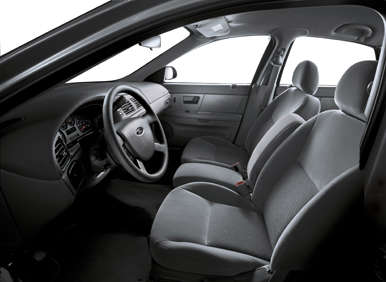
Ford Taurus Used-Car Buying Guide: 2008 - 2009
After the Ford 500 failed to catch on, the model was reissued as an all-new fifth-generation Taurus in 2008Power came from a 3.5L V6 producing 263 hp and 249 foot-pounds of torque. A six-speed automatic transmission routed power to either the front wheels, or all four wheels—making the 2008 Taurus an all-wheel drive model for the first time in the model’s history.
The 2008 Taurus also benefited significantly from the fact that the Ford 500 was scheduled for an update for the 2008 model year. Changes from the previous year’s 500 included a new front-end treatment, the 263 hp 3.5 L V6, and the six-speed transmission.
Additional improvements included the incorporation of stability control. The Ford Sync telematics system, which has been developed with Microsoft, enabled the hands-free use of mobile phones and voice control of digital music players.
Ford Taurus Used-Car Buying Guide: 2008
The 2008 Ford Taurus was offered in two trim levels, “SEL” and “Limited”.
Taurus SEL used 17-inch polished alloy wheels, variable intermittent wipers, a rear window defogger, two-way power seats for the passenger and a six-way height adjustable power seat for the driver—with manually adjustable lumbar support. The front passenger seat would fold flat, and the rear seat back was configured to split fold. There was also a rear armrest with storage and a set of rear ventilation ducts.
A digital keypad controlled the power door locks, the power windows were capable of one-touch operation, and power exterior mirrors were included as standard equipment as well. The SEL Taurus also featured cruise control, front console storage, front and rear cup holders, front and rear door pockets, and an overhead console with storage.
The 2008 Taurus SEL retained accessory power when its engine was shut off, there was a remote trunk release, and the front seat backs had storage pockets. The tilt adjustable steering wheel included audio and cruise controls in addition to controlling a power steering system.
Air conditioning, simulated wood trim on the center console and dashboard, front and rear reading lights, leather trim on the shift knob and steering wheel, front and rear floor mats, an electrochromatic inside rearview mirror, and dual illuminating vanity mirrors made the interior a more accommodating place to be. The 2008 SEL’s audio system was driven by an AM/FM in-dash single-disc CD player stereo unit, which incorporated an auxiliary input for portable audio devices.
Ford’s 2008 Taurus SEL’s safety suite consisted of four-wheel ABS, front and rear head airbags, a pair of front side-mounted airbags, child seat anchors, ventilated front/solid rear disc brakes, rear door child safety locks, and an engine immobilizer. There were also front fog lights, a passenger airbag occupant sensing deactivation system, a rear center three-point safety belt, and front seatbelt pre-tensioners.
Traction control, electronic brake force distribution, an emergency interior trunk release, and a tire pressure monitoring system rounded out the 2008 Ford Taurus SEL's safety gear package.
The 2008 Ford Taurus Limited used leather upholstery, 18-inch alloy wheels, all-wheel-drive, a center limited slip differential, a four-way power passenger seat with manually adjustable lumbar support, and a heated eight-way power driver’s seat. Taurus Limited also featured dual zone automatic climate controls, and an AM/FM in-dash six-disc CD player with CD MP3 playback capability and an auxiliary input port for portable audio devices. The head unit also supported full iPod integration. The 2008 Ford Taurus Limited was prewired for a cellular phone and also included a Bluetooth wireless data link.
On the safety front, to the SEL's safety kit, the Limited added automatic headlamps.
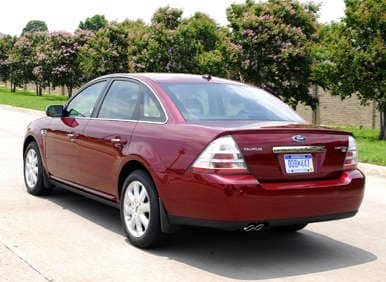
Ford Taurus Used-Car Buying Guide: 2009
Stability control was added to the list of standard safety features. An SE model was added to the lineup, incorporating 17-inch wheels, full power accessories, power seats, a leather-wrapped steering wheel, wood-grain (not genuine wood) interior trim, air-conditioning, a CD player with an auxiliary audio input jack, and cruise control.
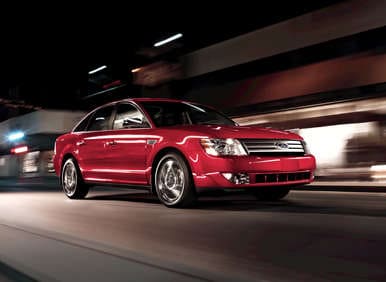
Ford Taurus Used-Car Buying Guide: 2010 – Current (2012)
Reborn for the 2010 model year as Ford's halo model, the all-new Taurus was positioned to bridge the gap between family sedans and luxury cars. The rebirth of the SHO model also added the performance aspect to the car's portfolio.
Completely redesigned, the new look—while not quite as revolutionary as the original Taurus—was handsome nonetheless. Further, a full array of cutting-edge technological features at a relatively affordable price made the new Taurus an outstanding value.
A choice of two engines were available, the standard engine was a 3.5 L V6, which produced 263 hp and 249 foot-pounds of torque. This engine was fitted to every Taurus model except the SHO. Its power was routed to either the front wheels, or all four wheels by way of a six-speed automatic transmission.
Taurus SHO was an all-wheel-drive proposition only and got a twin turbocharged version of the 3.5 L V6 good for 365 hp and 350 foot-pounds of torque.
Ford Taurus Used-Car Buying Guide: 2010
Capable of seating five people, the 2010 Ford Taurus was offered in “SE”, “SEL”, “Limited”, and “SHO” trim levels.
The standard equipment list for Taurus SE included 17-inch alloy wheels, automatic headlights, keyless entry and a SecuriCode entry pad. The model featured full power accessories, cruise control, a six-way power adjustable driver’s seat, a 60/40 split-folding rear seat, a tilt-and-telescoping steering wheel incorporating audio controls, and a six-speaker stereo with a CD/MP3 disc player and an auxiliary input jack for portable audio devices.
To all of the above, the SEL added 18-inch wheels, an automatic transmission with paddle shifters, a pair of heated side mirrors, a dual-zone automatic climate control system, an electrochromatic auto-dimming rearview mirror, and satellite radio.
As options for the SEL, Ford's product planners offered 19-inch wheels, rear parking sensors, a power passenger seat, ambient lighting, leather upholstery, and Ford’s Microsoft developed Sync system—incorporating Bluetooth streaming and a fully integrated iPod interface with voice control.
All of the above was standard fare on the Taurus Limited, which also got 10-way power front seats, driver memory functions, and an upgraded stereo system with a six-CD/MP3 disc player.
The top of the line Taurus SHO model added the twin turbocharged engine, a sport-tuned suspension system, high intensity discharge xenon headlamps, an auto-dimming electrochromic exterior driver’s mirror, a tail spoiler, as well as keyless ignition and entry, which was also optional on SEL and Limited. The SHO also featured an exclusive upgraded leather trim and faux-suede upholstery treatment for its seats.
Options varied according to trim level, but the highlights included a sunroof, remote start, power-adjustable pedals, heated front seats, a set of multicontour massaging seats, and a 12-speaker Sony-branded premium audio system.
Taurus Limited and SHO also offered adaptive cruise control with a collision warning system, a blind-spot warning system, automatic high beams, an electrochromic auto-dimming exterior driver mirror, rain-sensing wipers, cooled front seats, heated rear seats, a rear window power sunshade, and a navigation system.
The optional infotainment system featured an in-dash single-CD/DVD player, incorporating a hard drive with 10GB of digital music storage. The system also employed Sirius Travel Link, featuring real-time traffic, weather and other location-based information.
One could go all out and order a fully equipped Taurus SHO. This rocked 20-inch wheels, a rearview camera, and an SHO Performance package, which included performance brake pads, a recalibrated steering system, a more aggressive final-drive ratio, a stability control defeat option, and performance-oriented summer tires.
The 2010 Ford Taurus safety suite was comprised of standard antilock disc brakes, stability and traction control, front side airbags, and side curtain airbags. Optionally available safety features were a blind spot warning system, a pre-collision warning system, a cross-traffic warning system—which activated when a so-equipped Taurus model was put into reverse, rear parking sensors, and a rearview camera.
